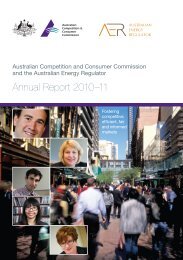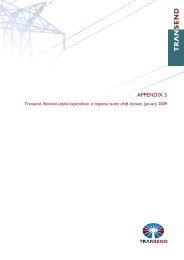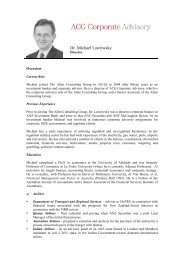Internal consistency of risk free rate and MRP in the CAPM
Internal consistency of risk free rate and MRP in the CAPM
Internal consistency of risk free rate and MRP in the CAPM
Create successful ePaper yourself
Turn your PDF publications into a flip-book with our unique Google optimized e-Paper software.
Appendix A. Assumptions used <strong>in</strong> DGM modell<strong>in</strong>g<br />
184. In order to estimate <strong>the</strong> average <strong>risk</strong> premium required by <strong>in</strong>vestors across Australian<br />
utilities equities I have sourced from Bloomberg median analyst forecasts for six<br />
regulated utilities bus<strong>in</strong>esses.<br />
185. The forecast cash amount <strong>and</strong> value <strong>of</strong> <strong>the</strong> dividends <strong>of</strong> <strong>the</strong> six regulated utilities firms<br />
are available only for three f<strong>in</strong>ancial year periods, <strong>in</strong>clud<strong>in</strong>g <strong>the</strong> current, next <strong>and</strong><br />
subsequent f<strong>in</strong>ancial year. There are no direct forecasts <strong>of</strong> dividends per share that<br />
we are aware <strong>of</strong> which extend beyond that period. To enable an estimate <strong>of</strong> <strong>the</strong><br />
required <strong>rate</strong> <strong>of</strong> return, we have extended <strong>the</strong> path <strong>of</strong> dividends <strong>in</strong>to perpetuity based<br />
on an assumed long run <strong>rate</strong> <strong>of</strong> growth from <strong>the</strong> f<strong>in</strong>al Bloomberg forecast.<br />
186. The Bloomberg forecasts cannot usually be directly compared to capitalisation <strong>of</strong> firms<br />
<strong>in</strong> order to estimate an implied <strong>rate</strong> <strong>of</strong> return because <strong>the</strong>se are forecasts <strong>of</strong> cash<br />
dividends, <strong>and</strong> as such do not <strong>in</strong>clude <strong>the</strong> value <strong>of</strong> imputation credits to <strong>in</strong>vestors.<br />
Usually, I would <strong>in</strong>clude <strong>the</strong> value <strong>of</strong> imputation credits consistent with a value for <strong>the</strong>ta<br />
<strong>of</strong> 0.35 <strong>and</strong> a proportion for franked dividends <strong>of</strong> 75%. 57 This means that on average<br />
each dollar <strong>of</strong> dividends had attached to it imputation credits valued by <strong>in</strong>vestors at<br />
11.125 cents ( ( )<br />
187. Accord<strong>in</strong>gly, I would apply an uplift factor to <strong>the</strong> Bloomberg cash dividend forecasts to<br />
reflect <strong>the</strong> value <strong>of</strong> imputation credits to <strong>in</strong>vestors. However, I have applied no such<br />
uplift factor to <strong>the</strong> six regulated utility firms because <strong>the</strong> majority <strong>of</strong> <strong>the</strong>se firms do not<br />
currently pay any imputation credits with <strong>the</strong>ir distributions. This means that <strong>the</strong><br />
result<strong>in</strong>g cost <strong>of</strong> equity for <strong>the</strong> utilities firms is a conservative estimate.<br />
188. There is general consensus that long run real dividend growth is best proxied by long<br />
run real economic growth. This is <strong>the</strong> assumption that is made by AMP, 58 Davis, 59<br />
Lally 60 <strong>and</strong> Damodaran 61 . I consider this approach is appropriate <strong>and</strong> have developed<br />
an estimate for real long run growth <strong>of</strong> 3.9%.<br />
189. The average annual <strong>rate</strong> <strong>of</strong> real growth <strong>in</strong> gross domestic <strong>in</strong>come between <strong>the</strong><br />
December quarter 1959 62 <strong>and</strong> September quarter 2010 was 3.99%. Comb<strong>in</strong>ed with an<br />
57 Sourced from Brailsford, T., J. H<strong>and</strong>ley <strong>and</strong> K. Maheswaran, Re-exam<strong>in</strong>ation <strong>of</strong> <strong>the</strong> historical equity <strong>risk</strong> premium <strong>in</strong><br />
Australia, Account<strong>in</strong>g <strong>and</strong> F<strong>in</strong>ance 48, 2008, page 85.<br />
58 AMP Capital Investors (2006), The equity <strong>risk</strong> premium – is it enough? Oliver’s <strong>in</strong>sights, Ed.13, 4. This methodology uses<br />
<strong>the</strong> long term average nom<strong>in</strong>al growth <strong>in</strong> GDP as a proxy for long term average nom<strong>in</strong>al growth <strong>in</strong> dividends).<br />
59 Davis, The weighted average cost <strong>of</strong> capital for <strong>the</strong> gas <strong>in</strong>dustry, Report prepared for <strong>the</strong> ACCC <strong>and</strong> ORG, 18 March 1998,<br />
p.15-16.<br />
60 Lally, The cost <strong>of</strong> capital under dividend imputation, Prepared for <strong>the</strong> ACCC, 2002, pp.29-34.<br />
61 Damodaran, op cit, p. 53.<br />
62 The Australian Bureau <strong>of</strong> Statistics (ABS) publishes economic growth figures on its website start<strong>in</strong>g <strong>in</strong> 1959. Here we use<br />
growth <strong>in</strong> real domestic <strong>in</strong>come <strong>of</strong> 3.9% (A2304314X <strong>of</strong> ABS Catalogue 5206.0) ra<strong>the</strong>r than nom<strong>in</strong>al growth, s<strong>in</strong>ce future<br />
expectations <strong>of</strong> <strong>in</strong>flation are not consistent with <strong>the</strong> high levels <strong>of</strong> <strong>in</strong>flation that were experienced at various times over this<br />
period.<br />
Competition Economists Group<br />
www.CEG-AP.COM<br />
50







